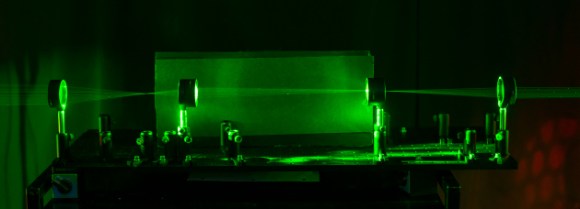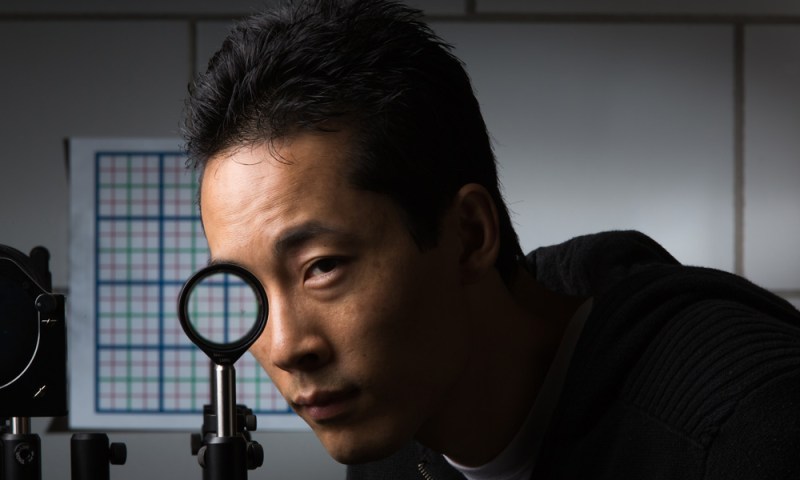Students at the University of Rochester have developed a clever optical system which allows for limited invisibility thanks to a bit of optic sorcery physics.
Almost all invisibility technologies work by taking light and passing it around the object as if it were never there. The problem is, a lot of these methods are very expensive and not very practical — and don’t even work if you change your perspective from a head on view.
[Joseph Choi] figured out you can do the same thing with four standard achromatic lenses with two different focal lengths. The basic concept is each lens causes the light to converge to a tiny point in between itself and the next lens — at which point it begins to diverge again, filling the following lens. This means the cloaked area is effectively doughnut shaped around the tightest focal point — if you block the center point of the lens, it won’t work. But everything around the center point of the lens? Effectively invisible. Take a look at the following setup using lasers to show the various focal points and “invisibility zones”.

Pretty cool stuff — let’s see someone in our community make one! Any cool applications come to mind? It’d be quite fun with giant lenses, but we think that would probably get quite expensive pretty fast…. More info can be found in their paper on Paraxial Ray Optics Cloaking.
[Thanks Slipster!]

















Diverge… converge… Ehhhhh close enough!
i don’t know anything about physics but if i wrote that i would feel humilitaed.
If I didn’t know anything about physics I would feel humiliated.
I just feel humiliated.
I see the article has been corrected, so now I can’t tell if you’re talking about my criticism or the article itself :-)
It’s hard to tell for sure from the limited number of shots in the video, but it still seems to have a flaw when not looking head on. Looks like the grid lines up seamlessly only if the camera is focused on or close to the background. In other shots where the focus is closer to where the “cloaked” object is, it doesn’t line up.
That’s 1. semester physics, what’s next? The magical light bulb?
nah, the potato battery.
Hey Hey! slow down there, this isn’t MIT! Potato Batteries are for Graduate level only!
I hear Aperture Labs still has some active patents in that field.
You monster.
They have explained the math behind the setup. One of the distances is t2=2 f2 (f1+ f2) / (f1— f2) and the other is t1=f1+f2. If both lenses had the just about the same focal length, the distance t2 becomes very large.If the focal lengths are now far apart, t2 will perhaps reduce, by t1 will increase. If we rearrange the terms,
t1/t2=0.5(f1/f2)-1, which means that we need f1 to atleast be twice f2 to yield a physically possible setup (else t1/t2 becomes 0).
Its an ingenious setup,not doubt, but maybe it has odd limitations.
I fail to see how this is any more advanced than an 8th grade science experiment using expensive lenses… Cool, but nothing new at all.
Wouldn’t it be cheaper, and more effective, to just use a double periscope anyway? Looks less like magic, but this one is still just a mild illusion, with no practical uses…
“no practical uses”, I always laugh when I see that. Lasers, at first were thought by many to have no practical uses whatsoever.
And this thing has been around for 200+ years, and still nobody found a practical use for it.
Things don’t have to be complex to be new or inventive.
This isn’t new or inventive either. Although it’s posted all over the internet as if it were. That may be the point of confusion.
since you have a converging beam like this in a telescope, you could place a wall at the focal point, with a small hole. The wall would block stray light bouncing around inside the telescope, increasing contrast.
You could call this a “Baffle”. http://www.berfield.com/baffles.html
Sounds like this could be revolutionary as far as cloaking devices go! Just make sure to trick the enemy into looking through this small lens…
Ugh, I read about this first on some remedial “news” site where they were yammering on about this being an incredible breakthrough towards an “invisibility cloak” with potential to be used by truck drivers to see through their trailer, and surgeons to see through their hands while operating….
I seriously doubt the people writing those articles even bothered to read the explanation of what was being done. I wish news sites could be fined for being so very stupid.
You’re not the only one who sees right through them.
oh, oh, oh, +1+2+3. Oh man that was awesome. Double decker, triple decker. That was great, thank you for that.
SciFi applications, large, specifically shaped gravity fields to shape the light, just keep any ships in your hidden invasion fleet out of the middle zone.
In essence this isn’t making the light go around objects, it’s compressing it into and through the center of a finite volume.
Honestly…i think this is no hack and i can’t understand why this is a big news. You don’t have nothing new or anything strange…it’s just two lenses with their focal point on the same “spot”. First year of any engineering bachelor your have this on experimental physics.
yes of course, you need at least 3 lenses or else the image will be inverted
Just because its simple from a physics standpoint doesn’t mean it isnt a novel usage.
I cant remember ever seeing this before.
sorry, you are completely right
there are things that are so obvious that you should not ever publish them.
Like that obnoxious comment of yours?
You’re so transparent.
So be weary if you see a set of four lenses being pushed around by People in uniform.
I think the main point of this research was to boil down what “cloaking” really is. Good on them for having the guts. Now there is no ambiguity about the topic. It’s been pretty frustrating to see even the really smart researchers get lost in the details of how to create lensing effects without any real cloaking being described in their research.
Hey, check out my cloaking device!
http://s27.postimg.org/aysli0tir/Bez_nazwy.jpg
Now, that’s just sorcery!
Not quite sorcery, I’ve spotted a mistake with the physics. That setup could be convincing for a person with more than one eye and would only distort apparent distance. Obviously real cloaking has to be totally unconvincing unless you are are a camera directly in line with their equipment.
Yeah there’s a reason for the grid behind him.
eeeh nvm I derped for a moment there.
That will be the next invention, once they all got their papers and call themselves professor.
Thx for wasting my time… That’s not even some clever use no one has ever thought about befor. Its just a simple fact. Normal people like engineers would place a stop arround the common focal point to minimize stray light. This stop would btw be invisible too, otherwise you would not place it there…
I wonder why researchers waste their time on such a setup trivial to any optical engineer.
“…normal people like engineers…”
YAAAAAY… I’m finally normal!!! When did this happen?
what’s important here isn’t that the method has many laminations but that someone has shown a relatively simple and cheap way with no electronic or moving parts to cloak something. It shows that ‘yet to be solved’ problems don’t always require advanced machines. When was the last time a breakthrough like this was made that did not involve some level of computing and or power?
For me this will serve as inspiration for my kids to learn more about science b/c it shows that they can do cool science (i.e. cloaking something) without the need for advanced computing devices and or the kind of tools/machines you’d in labs and similar places. The fact that they could do this at home in total safety (b/c there are no electrical or moving parts ) is amazing.
It has laminations!?
whole countries full of lemons… millions of them… leminations taking over the globe!
I can’t believe this guys are serious.. What kind of university is this? If I ever studied there I would be ashamed.
“it’s just a trick of the light, but if that’s all you have . . .”
The photo looks shopped. The whole left edge of that guy’s head looks completely bizarre and doesn’t match with the room lighting.
Door peephole unavailable for comment….
Seriously hope this was just for fun and not funded by the uni lol.
Hmmm. Paraxial ray optics? OK. The pattern in the plane that contains the point of convergence is the 2D Fourier Transform of the object. Passing the center of the pattern is the same as a low pass filter. I’m guessing that the grid is lower spatial frequency than anything else in the object, especially anything not symetrical. It is an old trick, and the way fast transforms (a fast FT, not FFT) were done in things like synthetic aperture radar. Still, nicely done here.
I learned about this effect when I was 8 years old. I put a scope on my BB gun, and the front sight was directly inline with the scope. Guess what, when looking through the scope the front sight was “cloaked”…
I don’t think I would call this a cloaking device, or anything of the sort. “Cloaking device” is a term that as far as I know came from star trek. In star trek the cloaking device “BENDS” electromagnetic radiation around an object, by using some type of distortion field. Now space does this all the time, its called gravitational lensing, which requires a massive, massive, massive, …..repeat a million times….amount of mass or energy, like singularities. I have no doubt that in the future we will someday build something from the knowledge that we can bend light much easier with less energy, and wield it on mobile devices that don’t also kill us, or destroy everything around it, and thats when the breakthrough happens. Just think about it, every break through always came at the rebuke of mainstream science and scientists, Galileo, Copernicus, Kepler, Newton, Einstein, sound barrier, and pretty much anything that reaches far enough, or anyone saying anything radical enough, especially when it might make it look like God exists, or God’s acts are observable/measurable, and not just pure supernatural. Until then all technology really isn’t achieving the desired effect or method. There is a small device that can cloak microscopic objects in the microwave spectrum, but still requires a physical object in between to achieve the effect, so still not a cloaking device.
Cloaking Device – Shmoking Device. This is just a good undergraduate optics class demonstration, nothing profound. It just goes to show how dead the current field of physics has become with so many running off developing unprovable theories, slamming particles together to fill in the gaps in their particle “collection”, and generally failing to provide any real improvement in our energy situation. The field has a serious need for a wake-up call and revival, and when that happens there are going to be some seriously bruised egos. (hope it happens soon)